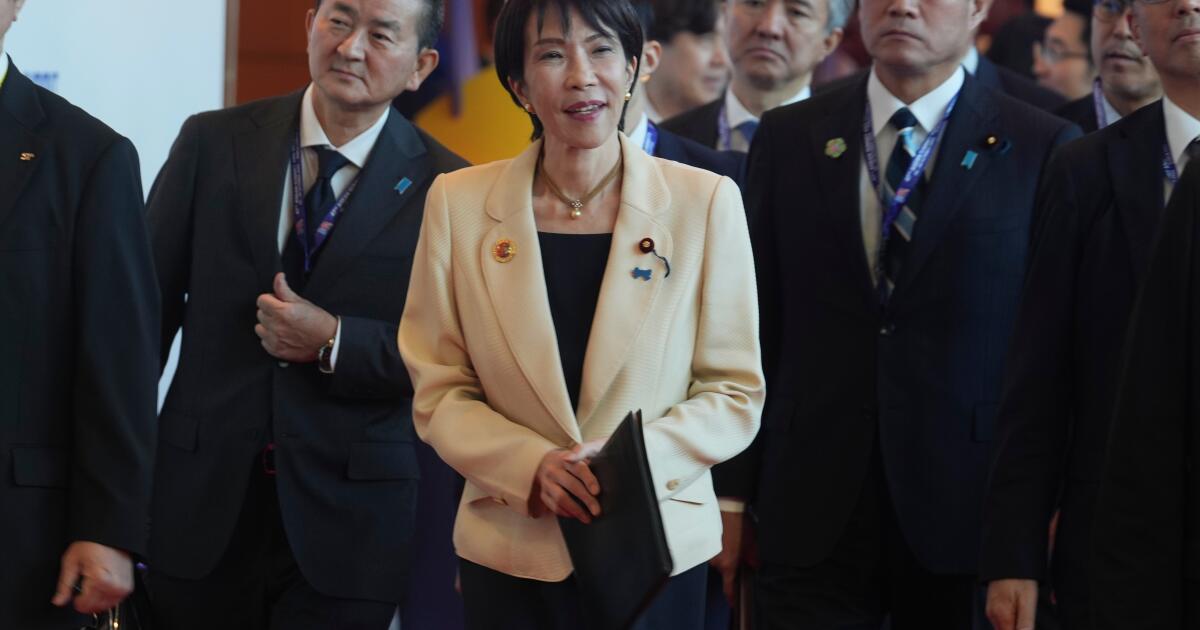For Japan’s new leader, the key to connecting with Trump could be a Ford F-150 truck
TOKYO — President Trump opened his visit to Japan on Monday with greetings from the emperor a day before he meets new Prime Minister Sanae Takaichi, who is banking on building a friendly personal relationship with the U.S. leader to ease trade tensions.
One key to this strategy might lie in an idea floated by Japan’s government to buy a fleet of Ford F-150 trucks, a meaningful gesture that may also be impractical given the narrow streets in Tokyo and other Japanese cities.
It’s an early diplomatic test for Takaichi, the first woman to lead Japan. She took office only last week, and has a tenuous coalition backing her.
Trump instantly bought into the idea of Ford trucks as he flew to Asia aboard Air Force One.
“She has good taste,” Trump told reporters. “That’s a hot truck.”
Japanese Emperor Naruhito welcomed Trump at the Imperial Palace after the president’s arrival, and the two spoke for about 30 minutes. Trump straightened his jacket as he stood next to Naruhito for photos before the two sat across a round table, with flowers in the middle, for their talks.
“A great man!” he said twice while pointing to the emperor. Trump last saw the emperor in 2019, soon after Naruhito ascended the Chrysanthemum Throne, becoming the first foreign dignitary invited to the palace.
Trump and Takaichi spoke over the phone while the president was mid-flight on Saturday. Takaichi stressed her status as a protege of the late Prime Minister Shinzo Abe, a favorite of Trump’s from his first term, and said she praised him for brokering the Gaza ceasefire that led to the return of hostages held by Hamas.
“I thought [Trump] is a very cheerful and fun person,” she said. “He well recognizes me and said he remembers me as a politician whom [former] Prime Minister Abe really cared about,” she said. “And I told the president that I extremely look forward to welcoming him in Tokyo.”
Trump spent Sunday in Malaysia, where he participated in a regional summit, and departed Monday morning for Japan. While on Air Force One on Monday, he said he planned to talk in Tokyo about the “great friendship” between the U.S. and Japan.
Resetting the trade relationship
Beneath the hospitality is the search for a strategy to navigate the increasingly complex trade relationship that Trump shook up earlier this year with tariffs.
Trump wants allies to buy more American goods and also make financial commitments to build factories and energy infrastructure in the U.S.
The meetings in Japan come before Trump’s sit-down with Chinese leader Xi Jinping on Thursday in South Korea.
Both the U.S. and Japan have sought to limit China’s manufacturing ambitions, as the emergence of Chinese electric vehicles, artificial intelligence and advanced computer chips could undermine the American and Japanese economies.
“In light of the planned meeting between Trump and Xi Jinping shortly afterward, Trump may also be considering how he might strengthen his hand by demonstrating the robustness of the U.S.-Japan relationship,” said Kristi Govella, Japan chair at the Center for Strategic and International Studies, a Washington think tank.
Japan’s previous administration agreed in September to invest $550 billion in the U.S., which led Trump to trim a threatened 25% tariff on Japanese goods to 15%. But Japan wants the investments to favor Japanese vendors and contractors.
Japan’s economy and trade minister, Ryosei Akazawa, has said his ministry is compiling a list of projects in computer chips and energy to try to meet the investment target.
“As far as I know, I’m hearing that there are a number of Japanese companies that are showing interest,” he told reporters Friday, though he did not give further details.
Ford trucks in Tokyo would be a powerful symbol
Japanese officials are looking at the possibility of buying more American soybeans, liquefied natural gas and autos. The U.S.-China trade conflict has shut American soybeans out of the Chinese market, leading China to seek more Brazilian supply. China reported no U.S. soybean imports in September, a first since November 2018.
For Trump, the prospect of Ford trucks in the skyscrapered streets of Tokyo would be a win. The administration has long complained that American vehicles were being shut out of a market that is the home of Toyota, Honda, Nissan, Isuzu, Mitsubishi and Subaru. In a September interview on CNBC, Commerce Secretary Howard Lutnick said Japan wouldn’t buy U.S.-branded vehicles because “Chevys” were popular with Japanese gangsters.
Takaichi may arrange for Ford F-150 trucks to be showcased in a place Trump gets to see them, Japan’s Nikkei newspaper reported. The government is considering importing the trucks for its transport ministry to use for inspecting roads and infrastructure, though there are concerns that the F-150 could cause congestion on narrow Japanese streets.
“We appreciate President Trump’s advocating for American made products,” Ford spokesperson Dave Tovar said. “We would be excited to introduce America’s best-selling truck to work and government customers in Japan.”
Japanese media have reported that Toyota Motor Corp. Chairman Akio Toyoda could announce plans to import his company’s American-made cars back to Japan during a dinner with Trump and other business leaders on Wednesday.
The gestures — combined with Takaichi’s connection to Abe — should help her deal with Trump, who seems predisposed to like her.
“I think she’s going to be great,” Trump said aboard Air Force One. “She’s a great friend of Mr. Abe, who was a great man.”
In 2016, Abe gave Trump a high-end golf club to celebrate his first election, and the leaders bonded over their love of golf. Trump often expresses sadness about Abe’s 2022 assassination.
But there are risks for Takaichi in emphasizing her ties to Abe, said Rintaro Nishimura, who specializes in Japan at the advisory firm The Asia Group.
“Because it’s Takaichi’s first diplomatic engagement I think she wants to start with sort of a bang,” Nishimura said. “Succeeding the Abe-line rhetoric is definitely going to be part of this engagement, although some also suggest that leaning too heavily on the Abe line might not exactly be good for her for creating her own kind of portfolio, her status as Japan’s leader.”
Following his meeting with Takaichi on Tuesday, Trump will give a speech aboard the USS George Washington aircraft carrier anchored in Japan, then hold a dinner with business leaders. Trump plans to leave for South Korea on Wednesday.
But aboard Air Force One on Monday, he told reporters that he was also ready to meet with North Korean leader Kim Jong Un, should that be an option.
“If he wants to meet, I’ll be in South Korea,” Trump said.
Boak and Yamaguchi write for the Associated Press. AP writer Chris Megerian contributed to this report from Kuala Lumpur, Malaysia.


